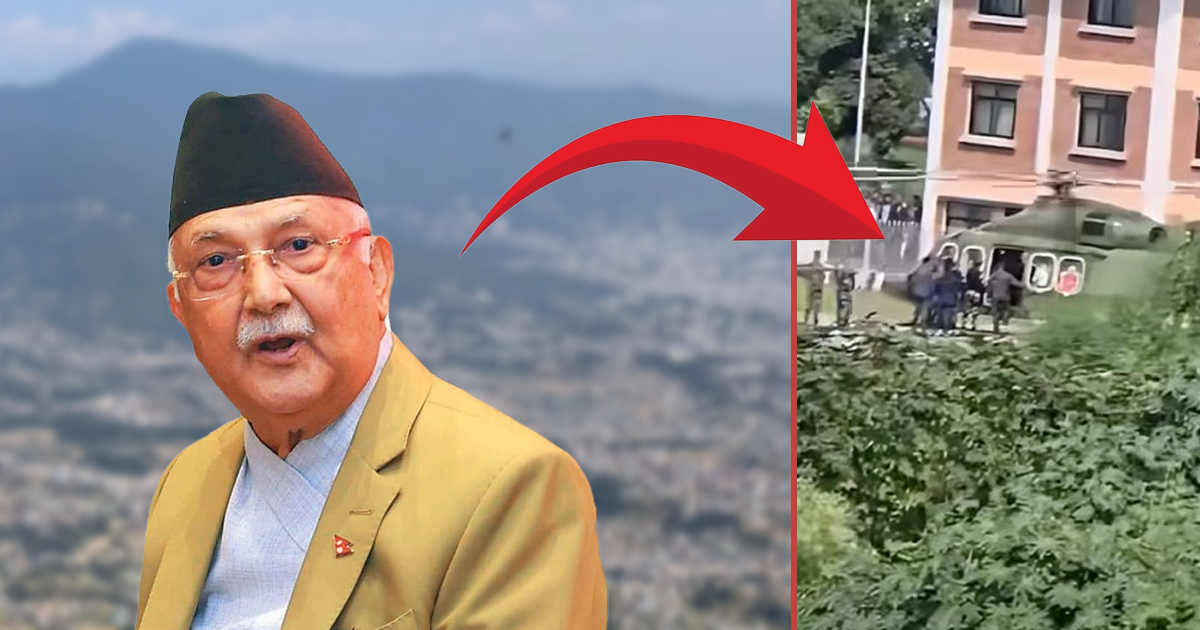Kathmandu: On September 8, during the Gen-Z movement, the then KP Sharma Oli–led government opened fire, killing 19 youths.
Enraged by the brutal suppression of young students by the state, demonstrators, including members of the Gen-Z movement, took to the streets on September 9 despite the curfew.
The Federal Parliament, Singha Durbar (the main government headquarters), the Supreme Court, the offices of the President and Prime Minister, ministerial quarters, and homes of top leaders of the three major parties, along with many other leaders across the country, were set on fire.
As fires broke out across various areas of Kathmandu, an emergency meeting of security chiefs was being held in Baluwatar.
Security officials urged then-Prime Minister Oli to resign, saying it had become difficult to ensure security arrangements. However, sources say Oli began speaking at length.
Referring to the time when Sikkim was annexed by India, he said the same pattern was being repeated — first burning police posts, then key structures, followed by a referendum to merge Sikkim with India. He accused protesters of attempting to repeat that process in Nepal.
Meanwhile, Chief of Army Staff Ashok Raj Sigdel continued receiving reports of deteriorating security conditions. He requested Oli to shorten his remarks and make a quick decision.
Oli, who had been determined not to resign, was shaken when he heard that Nepali Congress President Sher Bahadur Deuba and his wife, Foreign Minister Arzu Deuba, had been attacked by a mob. After that, he agreed to resign.
Although 19 youths had already died, Oli initially sought to suppress the incident. He only resigned when enraged protesters surrounded the Prime Minister’s official residence at Baluwatar.
Even after the uprising, Oli was reluctant to step down and was asking to deploy more policemen to crush the movement. But on September 9, when protesters encircled Baluwatar, he was forced to flee by army helicopter.
The Nepal Army then evacuated Prime Minister Oli and ministers from their quarters to a secure location.
After hiding under army protection for ten days, Oli moved on September 18 to a rented house in Gundu, Bhaktapur.
During his stay at the army barracks, reports circulated that a message had been issued in his name, allegedly written from “Shivapuri.” However, the authenticity of the message could not be confirmed.
Various media outlets also reported that Oli was being held in Shivapuri, but it was later confirmed that he was actually kept in Makwanpur.
“At that time, everyone believed KP Oli was in an army barrack in Shivapuri, but that wasn’t true,” a source told Clickmandu. “He was kept somewhere near Kulekhani.”
It was KP Sharma Oli himself who had recommended to President Ramchandra Paudel that Sushila Karki be appointed Prime Minister.
A few days after the Gen-Z movement, Maoist Centre leader Pushpa Kamal Dahal “Prachanda” on October 10 revealed that Karki had been appointed on Oli’s recommendation.
“After many Gen-Z members voted for Sushila on Discord, she was appointed according to the principle of necessity,” Prachanda said in a meeting with editors on Friday. “It was Oli who recommended her name to the President.”
According to sources, the Nepal Army coordinated the discussions to appoint Sushila Karki based on the Gen-Z votes on Discord. Kathmandu Mayor Balen Shah’s representative, Om Prakash Aryal — now the Home Minister — also participated in the discussions.
Once it was decided that Karki would become Prime Minister, President Paudel personally went to Kulekhani (Chitlang) to collect the official recommendation letter for her appointment.
According to a member of Karki’s cabinet, President Paudel himself flew by helicopter to retrieve the letter signed by Oli.
“The formation of the government was being delayed. As doubts began to spread, the President went by helicopter to Makwanpur to meet Oli,” the member said. “Only after receiving Oli’s recommendation did the President begin the process of appointing Karki as Prime Minister.”
Prachanda also confirmed this.
“Even though the army had moved Oli by helicopter to Hetauda or elsewhere, he was still the caretaker Prime Minister, and his recommendation was necessary,” Prachanda said. “The President had personally gone to meet him and brought back the letter.”
Sources claim the President returned from Kulekhani with Oli himself.
“When the President brought the recommendation letter to appoint Sushila as Prime Minister, he also brought Oli along,” the source said.
On the night of September 12, Sushila Karki took the oath of office as Prime Minister. The ceremony was held in a small building behind the burnt main structure of Sheetal Niwas (the presidential residence). Usually, former Prime Ministers attend such events.
However, only former Prime Minister Baburam Bhattarai was present at Karki’s oath-taking. Though his own house had been set on fire, Bhattarai still attended. Other former Prime Ministers — KP Oli, Prachanda, Madhav Nepal, and Jhalanath Khanal — were absent.
Sources claim that although then–Prime Minister KP Oli and former Prime Minister Prachanda were both inside Sheetal Niwas that day, neither attended the oath ceremony.



Comment Here